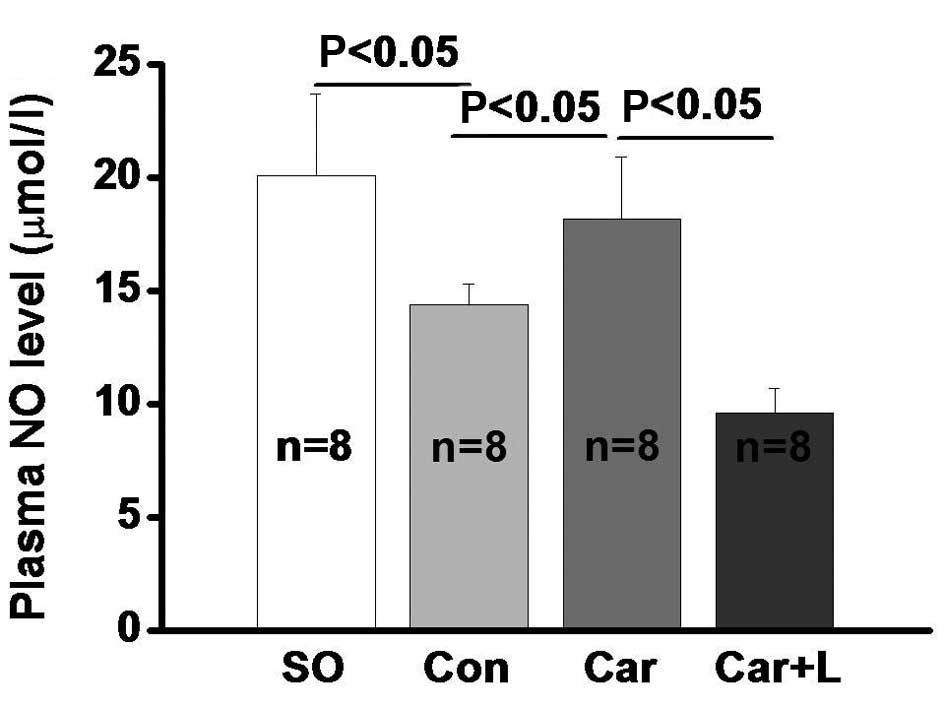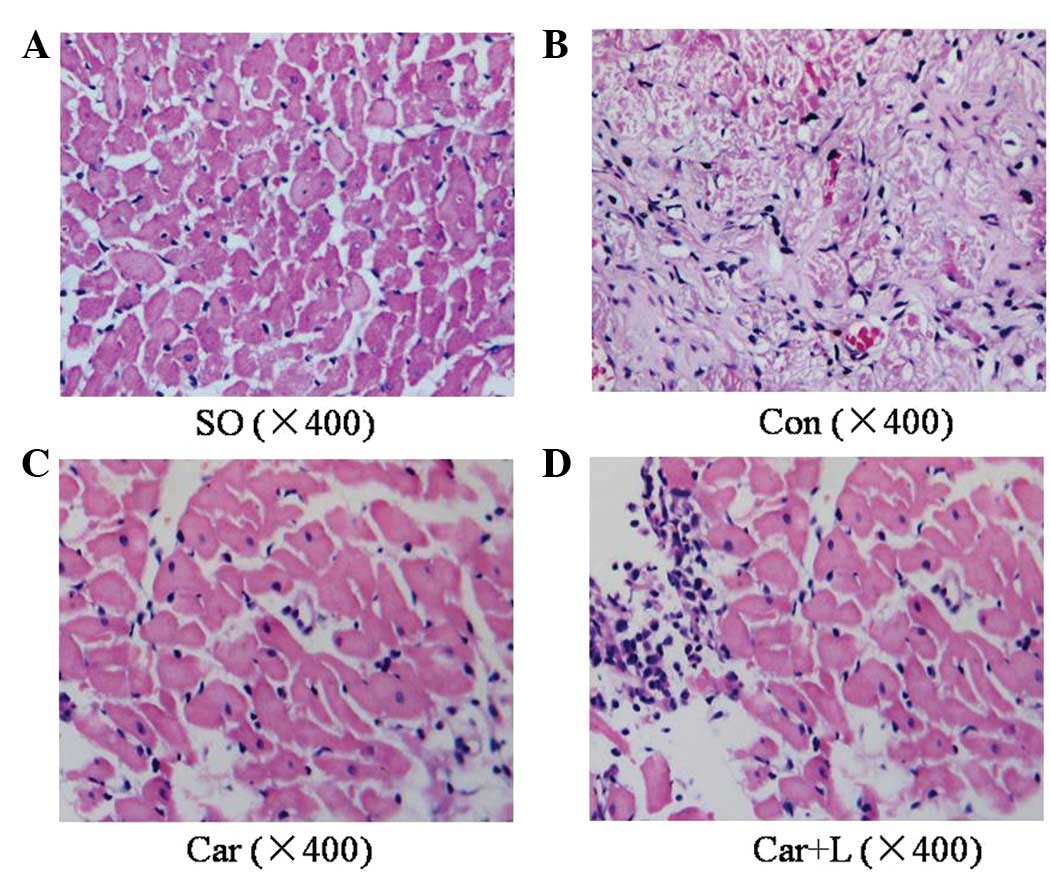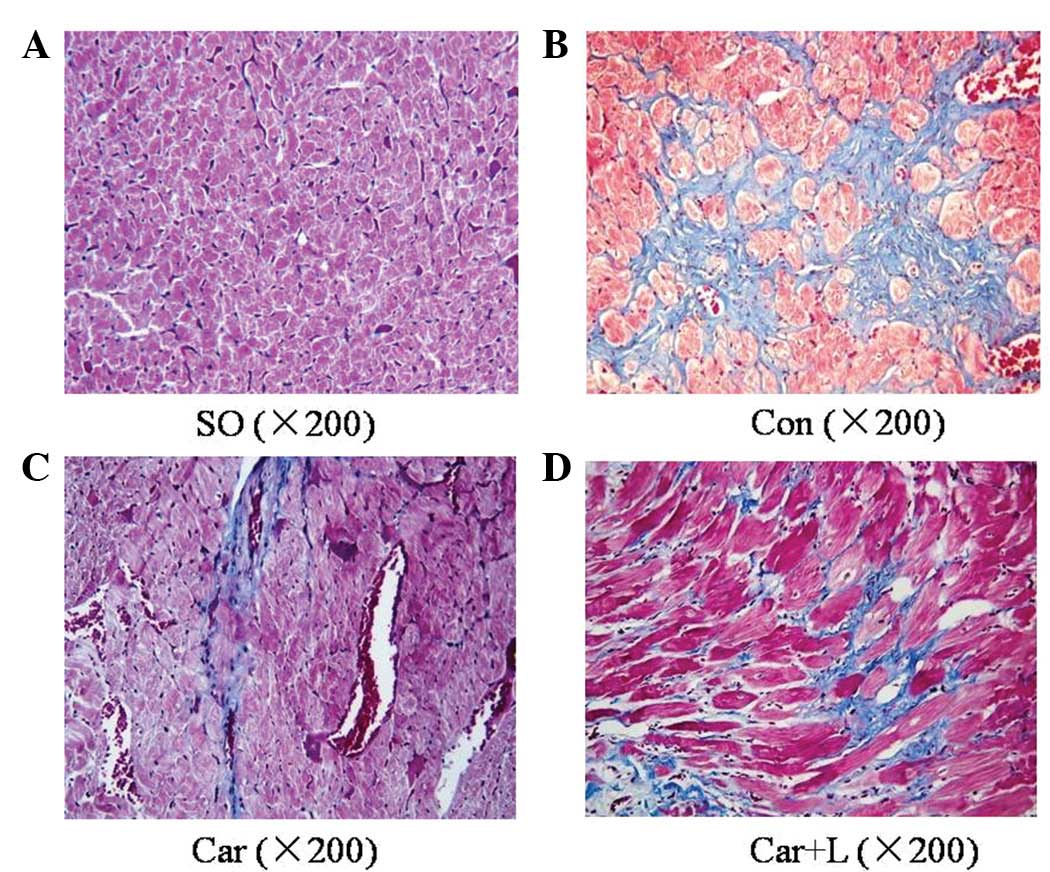The effects of carvedilol on cardiac structural remodeling: The role of endogenous nitric oxide in the activity of carvedilol
- Authors:
- Published online on: February 19, 2013 https://doi.org/10.3892/mmr.2013.1329
- Pages: 1155-1158
Abstract
Introduction
As a third-generation β-adrenergic blocker (β-blocker), carvedilol has been widely used for treating hypertension, myocardial infarction and heart failure (1–3). Although carvedilol is not superior to traditional β-blockers in blood pressure control, it still shows great benefit in the inhibition of collagen deposition (4). A previous study demonstrated that carvedilol’s action on blood pressure is largely mediated by endogenous nitric oxide (NO) (5). Considering the relationship between NO and left ventricle remodeling (6), we hypothesized that the effect of carvedilol on cardiac structural remodeling also depends on endogenous NO. In the present study, it was demonstrated that carvedilol reduces collagen volume fraction (CVF) and perivascular collagen area (PVCA) in a rat model of unilateral renal artery stenosis. The effect of carvedilol on cardiac remodeling is blunted by L-NAME, a specific inhibitor of NO synthase. The present study highlights the role of NO in the activity of carvedilol in cardiac structural remodeling.
Materials and methods
Animals and surgery
A total of 40 male Sprague-Dawley rats were used for narrowing the left renal artery using a modified 2-kidney 1-clip (2K1C) method. Briefly, all rats were anesthetized with urethane [5 mg/kg, intraperitoneally (i.p)], and the left kidneys were exposed by abdominal incision. A needle (0.25 mm, ID) was paralleled to place on the left renal arteries, and the arteries were gently tied together with silk. The needle was then pulled out and the blood was allowed to fill the left kidney as soon as possible in order to avoid irreversible damage. The abdomen was closed and the rats were gently placed in a warm cage until waking up. The animals were handled in strict accordance to the guidelines of the Institutional Animal Care and Use Committee of Wuhan University (Wuhan, China).
Blood pressure measurement and drug administration
Systolic blood pressure (SBP) of conscious rats was determined 4 weeks after surgery of 2K1C by the tail-cuff method. Three measurements were made per session, and the average value was obtained. Only the rats with SBP ≥160 mmHg (a total of 24 rats) were used for further treatments. These rats were randomly and equally classified into the control (Con), carvedilol-treated (Car) or carvedilol+L-NAME-treated groups (Car+L). An additional 8 rats were evaluated as the sham operation group (SO). These rats were fed with vehicle (distilled water, for SO and Con) or carvedilol (20 mg/kg/day) or carvedilol+L-NAME (20 and 25 mg/kg/day, respectively) by gastric gavage (7,8). SBP was continuously recorded in each rat from 1 to 8 weeks after administration of drug or vehicle.
Determination of plasma NO levels
At 8 weeks, all the rats were sacrificed following SBP measurement, and the blood was used to detect the NO (NO3) levels according to a previous study (5).
Histological diagnosis
Myocardium tissues were removed from the left ventricle (~3-mm thick) immediately following sacrifice. The samples were fixed in 10% pre-cooled paraformaldehyde for 72 h and embedded in paraffin for histological investigation. Paraffin-embedded tissues were sectioned into slices (~5 μm thick) and stained with hematoxylin and eosin (H&E). Masson’s trichrome staining was performed to assess myocardial fibrosis. Images were observed under an optical microscope at magnifications of ×400 (H&E) or ×200 (Masson’s). In order to quantitatively evaluate myocardial fibrosis, CVF and PVCA were calculated. CVF was defined as the sum of all the connective tissue areas of the entire section, divided by the sum of all the connective tissue and muscle areas in five fields of the section. PVCA was calculated as the ratio of the perivascular fibrotic area to the coronary vessel area from five fields of the section.
Statistical analysis
Data are presented as the means ± standard deviation (SD). Two-sample comparisons were performed using Student’s unpaired t-test, and four-sample comparisons were performed using one-way ANOVA (SPSS13.0). A P-value of <0.05 was considered to indicate a statistically significant difference.
Results
Four weeks after binding of the left renal artery, SBP in the Con group was significantly increased. As expected, carvedilol effectively decreased SBP only one week following drug treatment. SBP in the Car group reached a relatively lower lever over time compared with the level at the initiation of the treament and remained stable. Although the mean value of SBP was higher in the Car+L group, no statistical difference was detected between the Car and Car+L groups (149±7 mmHg, n=8, week 8 vs. 155±7 mmHg, n=8, week 8; P>0.05; Table I).
As previously reported (9), the concentration of plasma NO was significantly reduced in rats with hypertension (20.1±3.6 μmol/l in SO vs. 14.4±0.9 μmol/l in Con; P<0.05; Fig. 1). Carvedilol administration reversed the reduction of NO, although this effect was blocked by L-NAME (18.2±2.7 μmol/l in Car vs. 9.6±1.1 μmol/l in Car+L; P<0.05).
H&E and Masson’s staining showed that cardiac fibers exhibited an irregular shape and arrangement with myocardial fibrosis in the Con group. Moreover, the number of cardiac myocytes was markedly reduced. Carvedilol significantly suppressed these changes, although when combined with L-NAME, these effects were significantly blunted (Figs. 2 and 3). To quantitatively evaluate the influence of NO inhibition on the anti-remodeling effects of carvedilol, CVF and PVCA were calculated. Our results showed that carvedilol significantly decreased both CVF and PVCA in the hypertensive heart, although L-NAME blunted the effects caused by carvedilol (Table II).
Discussion
Different from traditional β-blockers, the mechanism underlying the blood pressure-lowering effect of carvedilol is more complicated (10). As well as the blockade of α1, β1 and β2 adrenergic receptors, Afonso et al(5) demonstrated that carvedilol’s action on blood pressure was largely dependent on NO (5). However, this conclusion was obtained from normal rats, and it remains unknown whether NO plays an important role on carvedilol’s action under pathological conditions. In the present study, high blood pressure was successfully induced by narrowing the left renal artery in the Con group, and was significantly decreased by the administration of carvedilol. Notably, inhibition of NO generation by L-NAME (Car+L group) appeared not to attenuate carvedilol effect on lowering blood pressure, although the mean value of SBP remained higher in the Car+L group compared with that in the Car group. This may be explained by the following factors: In the study by Afonso et al(5), carvedilol and L-NAME were used in normal rats for a short period of time, while in the present study, hypertension was firstly induced in rats and then drugs were administered for 8 weeks. Carvedilol effect on blood pressure may shift from the NO-dependent pathway to the α- and β-adrenergic receptor-dependent pathway after exposure to long and continuous pathological stimulations, such as high blood pressure, angiotensin II and catecholamine.
Besides blood pressure control, carvedilol can also bring benefit to patients with hypertension through its antihypotrophic effects. Previous studies have demonstrated that carvedilol prevents apoptosis and attenuates or reverses cardiac remodeling in various animal models, such as heart failure and ischemia/reperfusion injury (11,12). Since carvedilol increases the production of endogenous NO and NO prevents hypertrophy through cGMP/PKG pathway (13), we hypothesized that NO plays an important role in carvedilol effects on anti-remodeling. Our data showed that carvedilol reverses the reduction of serum NO level in rats with hypertension, and significantly decreases both CVF and PVCA. However, in the Car+L group these effects of carvedilol on CVF and PVCA appeared to be significantly attenuated. This means that the anti-remodeling effect of carvedilol in hypertrophy is largely dependent on endogenous NO. On the other hand, our results demonstrated that, as a critical anti-remodeling factor, endogenous NO plays an important role in the process of hypertrophy. In the future, more studies should focus on the mechanisms underlying how carvedilol increases the generation of endogenous NO.
As a third-generation β-blocker, carvedilol has been widely used in patients with hypertension, heart failure or coronary heart disease, and shows great advantages besides lowering blood pressure. In the present study, we showed that carvedilol significantly suppresses myocardial fibrosis and decreases both CVF and PVCA, while these effects were attenuated by L-NAME through inhibiting the generation of endogenous NO. Our study highlights the role of endogenous NO in carvedilol’s action on cardiac structural remodeling. In the future, further studies will focus on the mechanisms underlying how carvedilol increases the generation of endogenous NO.
References
|
DiNicolantonio JJ and Hackam DG: Carvedilol: a third-generation β-blocker should be a first-choice β-blocker. Expert Rev Cardiovasc Ther. 10:13–25. 2012. | |
|
Fonarow GC, Lukas MA, Robertson M, Colucci WS and Dargie HJ: Effects of carvedilol early after myocardial infarction: analysis of the first 30 days in Carvedilol Post-Infarct Survival Control in Left Ventricular Dysfunction (CAPRICORN). Am Heart J. 154:637–644. 2007. View Article : Google Scholar | |
|
Bozkurt B, Bolos M, Deswal A, Ather S, Chan W, Mann DL and Carabello B: New insights into mechanisms of action of carvedilol treatment in chronic heart failure patients - a matter of time for contractility. J Card Fail. 18:183–193. 2012. View Article : Google Scholar : PubMed/NCBI | |
|
Wei S, Chow LT and Sanderson JE: Effect of carvedilol in comparison with metoprolol on myocardial collagen postinfarction. J Am Coll Cardiol. 36:276–281. 2000. View Article : Google Scholar : PubMed/NCBI | |
|
Afonso RA, Patarrão RS, Macedo MP and Carmo MM: Carvedilol’s actions are largely mediated by endogenous nitric oxide. Rev Port Cardiol. 25:911–917. 2006. | |
|
Inaba S, Iwai M, Furuno M, Kanno H, Senba I, Okayama H, Mogi M, Higaki J and Horiuchi M: Role of angiotensin-converting enzyme 2 in cardiac hypertrophy induced by nitric oxide synthase inhibition. J Hypertens. 29:2236–2245. 2011. View Article : Google Scholar : PubMed/NCBI | |
|
Li B, Liao YH, Cheng X, Ge H, Guo H and Wang M: Effects of carvedilol on cardiac cytokines expression and remodeling in rat with acute myocardial infarction. Int J Cardiol. 111:247–255. 2006. View Article : Google Scholar : PubMed/NCBI | |
|
Rossoni G, Manfredi B, De Gennaro Colonna V, Berti M, Guazzi M and Berti F: Sildenafil reduces L-NAME-induced severe hypertension and worsening of myocardial ischaemia-reperfusion damage in the rat. Br J Pharmacol. 150:567–576. 2007. View Article : Google Scholar : PubMed/NCBI | |
|
Isabelle M, Simonet S, Ragonnet C, Sansilvestri-Morel P, Clavreul N, Vayssettes-Courchay C and Verbeuren TJ: Chronic reduction of nitric oxide level in adult spontaneously hypertensive rats induces aortic stiffness similar to old spontaneously hypertensive rats. J Vasc Res. 49:309–318. 2012. View Article : Google Scholar : PubMed/NCBI | |
|
Dulin B and Abraham WT: Pharmacology of carvedilol. Am J Cardiol. 93:3B–6B. 2004. View Article : Google Scholar | |
|
Bellenger NG, Rajappan K, Rahman SL, Lahiri A, Raval U, Webster J, Murray GD, Coats AJ, Cleland JG and Pennell DJ; CHRISTMAS Study Steering Committee and Investigators. Effects of carvedilol on left ventricular remodelling in chronic stable heart failure: a cardiovascular magnetic resonance study. Heart. 90:760–764. 2004. View Article : Google Scholar : PubMed/NCBI | |
|
Schulz R, Kelm M and Heusch G: Nitric oxide in myocardial ischemia/reperfusion injury. Cardiovasc Res. 61:402–413. 2004. View Article : Google Scholar : PubMed/NCBI | |
|
Lindman BR and Chakinala MM: Modulating the nitric oxide - cyclic GMP pathway in the pressure-overloaded left ventricle and group II pulmonary hypertension. Int J Clin Pract Suppl. 168:15–22. 2010. View Article : Google Scholar : PubMed/NCBI |












